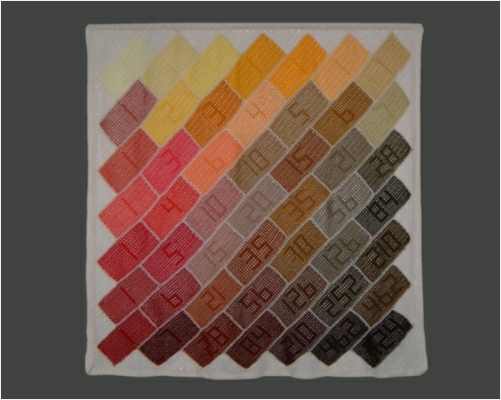

Click to read general information about afghans

©Woolly Thoughts 2018 Contact Us
Buy the pattern on the Order Form
or


Buy a pattern
for this afghan
on the order form
 Buy now
Buy now


MERE BAGATELLE
Starting at brick number one, and always moving forwards, how many different paths can you take to reach the brick at the bottom?
The answer is on the brick : 924
This design is a section of Pascal's triangle turned through 45 degrees. If you turn it so that the number 924 is at the bottom then the number on each "brick" is the sum of the two numbers above it.
The mathematics of this design is related to the old-

Scroll down for more information about
Mere Bagatelle



RELATED DESIGNS
NUMBER AFGHANS

CONSTRUCTION INFORMATION
Each brick is made separately in filet crochet.
The bricks are stitched or crocheted together.

CROCHET INFORMATION
Mere Bagatelle is made from 49 similar bricks, each in a different colour.
This is an ideal design for using up small amounts of left over
yarn.
Any type of yarn can be used but all the yarns should be of the same thickness to make regular sized bricks.
Mere Bagatelle is a representation of Pascal’s Triangle.
The American mathematician Martin Gardner said:
The pattern is so simple that a 10 year old can write it down, yet it contains such inexhaustable riches and links with so many seemingly unrelated aspects of mathematics, that it is surely one of the most elegant number arrays.
Although this pattern is named after Blaise Pascal (1623 -
The diagram shows why it is called a triangle. The afghan design uses only the part shown in red. The numbers in the pattern are generated by adding two adjacent numbers together and writing the total underneath. It could be continued for ever.
The afghan design was inspired by a problem which involves counting the number of different ways it is possible to reach any given stone, starting with the 1 at the top and always moving forwards. The answers are those given in the triangle.
The numbers in the afghan are deliberately made difficult to read so that it is not immediately obvious that the answer is given in the puzzle.
|
|
|
|
|
|
|
|
|
|
|
|
|
1 |
|
|
|
|
|
|
|
|
|
|
|
|
|
|
|
|
|
|
|
|
|
|
|
|
|
1 |
1 |
|
|
|
|
|
|
|
|
|
|
|
||
|
|
|
|
|
|
|
|
|
|
|
1 |
2 |
1 |
|
|
|
|
|
|
|
|
|
|
|||
|
|
|
|
|
|
|
|
|
|
1 |
3 |
3 |
1 |
|
|
|
|
|
|
|
|
|
||||
|
|
|
|
|
|
|
|
|
1 |
4 |
6 |
4 |
1 |
|
|
|
|
|
|
|
|
|||||
|
|
|
|
|
|
|
|
1 |
5 |
10 |
10 |
5 |
1 |
|
|
|
|
|
|
|
||||||
|
|
|
|
|
|
|
1 |
6 |
15 |
20 |
15 |
6 |
1 |
|
|
|
|
|
|
|||||||
|
|
|
|
|
|
1 |
7 |
21 |
35 |
35 |
21 |
7 |
1 |
|
|
|
|
|
||||||||
|
|
|
|
|
1 |
8 |
28 |
56 |
70 |
56 |
28 |
8 |
1 |
|
|
|
|
|||||||||
|
|
|
|
1 |
9 |
36 |
84 |
126 |
126 |
84 |
36 |
9 |
1 |
|
|
|
||||||||||
|
|
|
1 |
10 |
45 |
120 |
210 |
252 |
210 |
120 |
45 |
10 |
1 |
|
|
|||||||||||
|
|
1 |
11 |
55 |
165 |
330 |
462 |
462 |
330 |
165 |
55 |
11 |
1 |
|
||||||||||||
|
1 |
12 |
66 |
220 |
495 |
792 |
924 |
792 |
495 |
220 |
66 |
12 |
1 |
|||||||||||||
